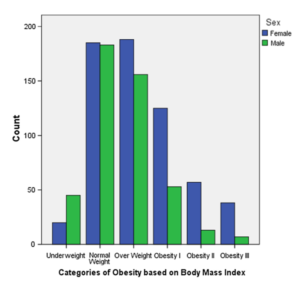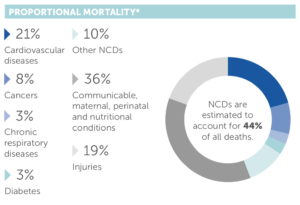Obesity in Afghanistan: the Increasing Burden of NCDs on the Afghan Population
One of the major non-communicable diseases (NCDs) affecting the population in Afghanistan is obesity – in Jalalabad city, 32% of people were overweight and 27% were obese according to a 2015 study. There are only a few studies on NCDs and related risk factors in Afghanistan, including the ones by Kwaja Mir Islam Saeed on Prevalence of Risk Factors for Non-Communicable Diseases in Adult Population of Urban Areas in Kabul City, Afghanistan and Prevalence and associated risk factors for obesity in Jalalabad city – Afghanistan.
The results of the 2015 study are in accordance with other regions of the world where numbers cluster around 30%. Most of the participants in the Jalalabad study are illiterate (with heavier burden on women) and are not from high socioeconomic backgrounds. Those who are illiterate were significantly more likely to be obese than literate subjects. Similar correlations between improved health and higher level of education were recorded in other studies. Taking into account the literacy level when developing health promotion materials and programmes is key to ensure that the targeted audience can be reached.

Figure 1: Graphic distribution of obesity categories by sex
Additionally, this study shows that obesity does not affect just the people coming from high socioeconomic backgrounds but cuts across the various population groups, also keeping in mind that increasing age contributes to higher proportion of overweight and obese people. While the older population is affected more severely by obesity and other NCDs, the behavioural patterns contributing to various risk factors (smoking or snuffing tobacco, physical activity, alcohol use, eating habits) are carried over to the younger generation and established often at an early age (smoking as early as 15 years old).
The risk of obesity is also higher for women (Figure 1). This is both due to less physical activity and also cultural norms. Obese and overweight women are perceived as more beautiful and healthy – as such, they are less interested in losing weight. With regards to physical activity, not only that women are less active, in urban areas, they also have less access to sport centres and jogging lots than men. These obstacles should be taken into account when developing health-improving strategies.
Similarly to other low-income countries, Afghanistan suffers from a double disease burden of still dealing with communicable diseases, improving maternal health or decreasing malnutrition while facing the health complications of NCDs as the life expectancy increases from 55 years in 2000 to 64 years in 2017. Moreover, due to the prolonged conflict, Afghanistan is still in transition and it is predicted that the burden of NCDs will increase in the upcoming years along with the aging population.

Figure 2: Proportional mortality in Afghanistan*
In 2016, NCDs were responsible for 44% of all deaths in Afghanistan while communicable diseases, perinatal, and nutritional conditions all together caused 36% of deaths (Figure 2*). This increasing in the proportion of deaths due to NCDs in comparison to other causes (communicable diseases or injuries) is observable all over the world. While the Afghanistan government and its partners still mainly focus on communicable diseases, maternal health, malnutrition, and vaccine preventable diseases, NCDs and related health factors do not receive the same level of attention.
Gathering data on NCDs, drug or tobacco use is an important step in filling the knowledge gap, but there is still a significant lack of reliable information on noncommunicable diseases or lifestyle habits due to years of conflict. To ensure sound policy and strategies aiming to deal with NCDs can be developed by the NCD department of the Ministry of Public Health and similar organisations, more interdisciplinary studies are needed. Furthermore, researchers and policy-makers can also draw on conclusions from similar studies in the other countries within the region.
Tackling obesity should take into account other interlinked NCDs such as hypertension and diabetes. In a 2013 study of adults in Kabul, many of the participants demonstrated double or triple risk factor for obesity, hypertension, and diabetes or any combination of two of them for the double factor. While, as mentioned above, literacy and education level are an important factor for a lower frequency of obesity, interestingly, the 2013 study in Kabul showed that illiterate participants were less likely to be diabetic in comparison to literate subjects. This further demonstrates that NCDs and their interlinkages are complex and further studies of population behaviours as well as nation-wide collection of health data are required.
* The mortality estimates for this country have a high degree of uncertainty because they are not based on any national NCD mortality data
Figures from:
(Saeed, K. (2015). Prevalence and associated risk factors for obesity in Jalalabad city – Afghanistan. Alexandria Journal of Medicine, 51(4), pp.347-352.)
(World Health Organization - Noncommunicable Diseases (NCD) Country Profiles, 2018)




Hi Jana, this is a great post – well structured and comprehensive. Out of curiosity, what current approaches have been undertaken in Afghanistan to deal with obesity? Anything from the National strategy that caught your eye? I thought of the reading Offline: time to radically rethink NCDs after reading your blog. The unsolved paradox in conflict-affected settings is very relevant in these settings. Thanks for sharing
Evelyn